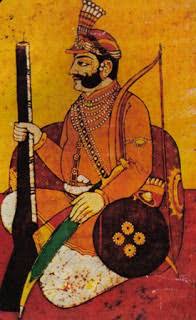
The Third Battle of Panipat took place on 14 January 1761 between the Maratha Confederacy and the invading army of the Durrani Empire. The battle took place in and around the city of Panipat, approximately 97 kilometres (60 mi) north of Delhi. The Afghans were supported by three key allies in India: Najib ad-Dawlah who persuaded the support of the Rohilla chiefs, elements of the declining Mughal Empire, and most prized the Oudh State under Shuja-ud-Daula. The Maratha army was led by Sadashivrao Bhau, who was third-highest authority of the Maratha Confederacy after the Chhatrapati and the Peshwa. The bulk of the Maratha army was stationed in the Deccan Plateau with the Peshwa.

Bajirao I was the 7th Peshwa of the Maratha Confederacy. He after Shivaji is considered to be the most charismatic and dynamic leader in Maratha history. He was just twenty years old and already had a reputation for rapid decisions and a passion for military adventure. He is considered one of the greatest Military generals of his time.

The Peshwa was the second highest office in the Maratha Confederacy, next in rank and prestige only to that of the Chhatrapati. Initially serving as the appointed prime minister in the Maratha Kingdom, the office became hereditary when Shahu gave the seat of Peshwa to Bajirao Ballal. During the reign of Shahu, the office of Peshwa grew in power and the Peshwas came to be the de facto rulers of the Maratha Confederacy. Eventually, the Chhatrapati title became titular and the main heads were the Peshwas according to the Sangola pact.

Madhavrao I was the son of Peshwa Balaji Bajirao and grandson of Peshwa Bajirao I who served as 9th Peshwa of the Maratha Confederacy. During his tenure, the Maratha Confederacy recovered from the losses suffered during the Third Battle of Panipat, an event known as the Maratha Resurrection.

Mastani was the daughter of Chhatrasal Bundela and Ruhani Bai Begum. She was the second wife of the Maratha Peshwa Baji Rao I. Her relationship within the Maratha Brahmin family has been subject of both admiration and controversy and well adapted in Indian novels and cinema.

Chhatrasal Bundela or Maharaja Chhatrasal was the Bundela Raja of Panna from 1675 to 1731. He is well known for his resistance against the Mughal Empire.

Sadashivrao Bhau Bhatt was son of Chimaji Appa and Rakhmabai and the nephew of Baji Rao I. He was a finance minister during the reign of Maratha king Rajaram II. He led the Maratha army at the Third Battle of Panipat.

Ibrahim Khan Gardi was a South Indian Muslim general of the Maratha Confederacy. An expert in artillery, he initially served the Nizam of Hyderabad, before working for the Peshwa of the Maratha Confederacy. As a Maratha general, he commanded a force of 10,000 men, infantry and artillery. He was captured and killed by the Durrani soldiers during the Third Battle of Panipat in 1761.
Parvatibai was second wife of Sadashivrao Bhau. She was from the Kolhatkar family of Pen and was married to Sadashivrao Bhau after the death of his first wife Umabai and hence became a member of the Peshwa family. She was also a trusted confidante of Shahuji. Her niece Radhikabai was married to Vishwasrao.

Vishwasrao Bhat was the eldest son and heir of Peshwa Balaji Baji Rao of the Maratha Empire. From early in his life, he was trained in administrative matters and exposed to military training since childhood. He died while fighting on the front lines during the Third Battle of Panipat.
Visaji Krushna Chinchalkar, popularly known as Visaji Pant Biniwale, was one of the leading generals of Peshwas in Northern India during 1759 to 1772. Peshwa Madhavrao I mainly sought his assistance in his attempt to restore Maratha Empire in the North after the defeat in the Battle of Panipat (1761).
Mahadaji Ballal Karkare was an accountant, Special Envoy of Peshwas, tutor and advisor of Peshwa Madhavrao I and Sawai Madhavrao. He was preceptor of Peshwa Madhavrao (I), when he was a child. He afterwards became Peshwa's domestic priest. Later he was his private treasurer.

Chimnaji Damodar Moghe, popularly known as Chimnaji Damodar, was among the first Sardars to cross the boundary of Maharashtra to engage Mughal forces located in the central and northern regions of India in 1698. He also served as Rajadnya in the court of Shahu I and as Peshwa in the court of Sambhaji II of Kolhapur.
Ranoji Bhoite was a Maratha chieftain of the Bhoite clan who lived in the 18th century. The Commander in Chief of the Maratha army from satara He was a contemporary of Ranoji Shinde, Dattaji Shinde, and others. Bhoite was an active Commander in Maratha's North India Campaign. Some Maratha leaders survived after the Panipat battle and created their own kingdoms, but Bhoite did not. He served under King Shahu in the Satara Kingdom.

Dattaji Rao Shinde, also known as Dattaji Rao Scindia, was the second son of Ranoji Rao Shinde and Maina Bai, alias Nimba Bai. His elder brother was Jayappaji Rao Shinde and his younger brother was Jyotiba.

Jankoji Rao Shinde was the third Maharaja of Gwalior State. He became Maharaja of Gwalior after the death of his father, Jayappaji Rao Scindia, at the age of 10.
Shamsher Bahadur I, was a ruler of the Maratha dominion of Banda in northern India. He was the son of Bajirao I and Mastani.
Kashibai Bhat was the first wife of Bajirao I, the Peshwa to the fourth Maratha Chhatrapati (Emperor) Shahu. With Bajirao, she had four children, including Balaji Baji Rao and Ragunath Rao. Balaji succeeded Bajirao as Peshwa upon the latter's death in 1740. Also following Bajirao's death, Kashibai fostered her step-son, Shamsher Bahadur, whose mother was Bajirao's second wife, Mastani.

The Bhatt Peshwa family earlier known as Bhat family is a prominent Indian Maratha Chitpavan Brahmin family who dominated India for around 100 years in the late 18th century and early 19th century. Most of the members in this family were the Peshwas in the Peshwa era of the Maratha Confederacy, and Peshwa later became their family name. During their regime, most of the Indian subcontinent was under their control. The last Peshwa, Baji Rao II, was defeated by the British East India Company in the Third Anglo-Maratha War in 1818. The territory was annexed to the British East India Company's Bombay Presidency, and he was pensioned.
The Saugor subha was a province of the Maratha Empire comprising the central Indian territories of the Peshwa or prime minister. It was ruled by hereditary Maratha Pandit governors who had their headquarters at the city of Sagar.












